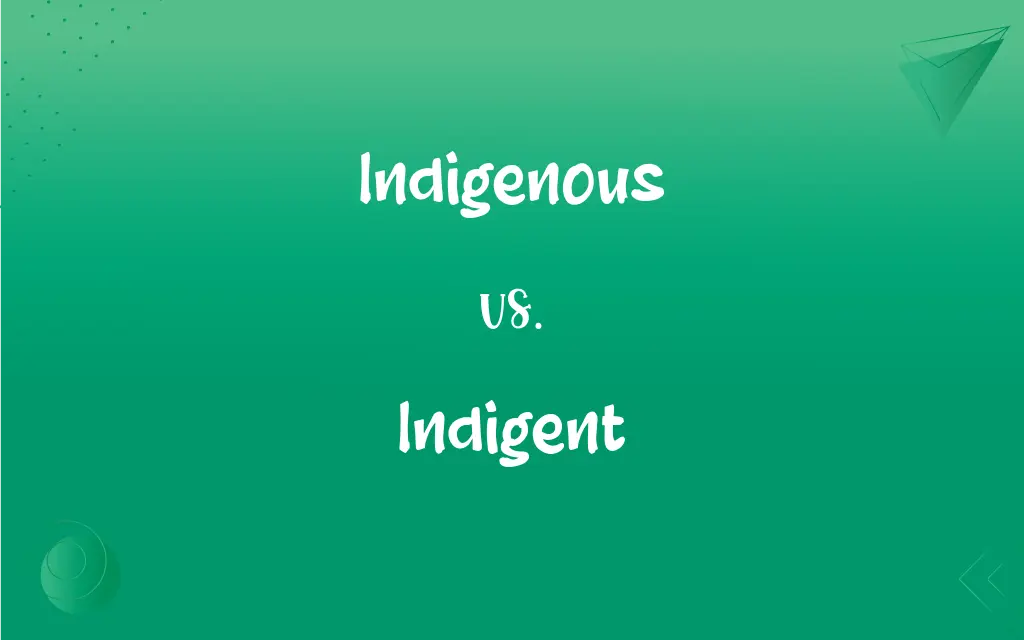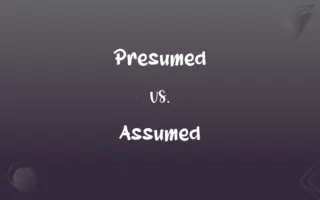Indigenous vs. Indigent: What's the Difference?
Edited by Aimie Carlson || By Janet White || Updated on February 5, 2024
Indigenous refers to people or things native to a particular place, while indigent means lacking food, clothing, and other necessities of life due to poverty.

Key Differences
Indigenous and indigent, though phonetically similar, diverge significantly in meaning and context. Indigenous pertains to the original inhabitants of a region or those that have a long history in an area, embodying the cultural, social, and historical contexts of a specific geographical location. It signifies a deep connection to a place, often emphasizing a group's traditional roots and heritage within that locale. Conversely, indigent describes a state of poverty, where individuals or groups lack basic needs such as food, clothing, and shelter. This term does not imply a connection to a specific place but rather a socio-economic condition.
The concept of being indigenous is deeply tied to identity, community, and belonging. It reflects an intrinsic relationship between people and their ancestral lands, including their traditions, languages, and practices that have been preserved and passed down through generations. This connection to land and culture distinguishes indigenous groups from others who might settle or colonize a region later. Indigent, on the other hand, refers to a condition of financial destitution that can affect anyone, regardless of their ethnic or cultural background. It highlights a critical need for basic sustenance and support, focusing on the material aspects of living conditions rather than cultural identity.
In discussions on rights and social justice, both terms are significant but address different issues. Indigenous rights often focus on protecting the sovereignty, land, and cultural heritage of indigenous peoples, acknowledging their unique status and contributions to humanity's diversity. Discussions surrounding the indigent revolve around socio-economic rights, access to resources, and policies aimed at alleviating poverty and ensuring that basic human needs are met. Both require attention and action from governments, organizations, and society to address historical injustices and current inequalities.
Indigenous status is inherent to a person's or community's historical and cultural identity within a specific region, while indigence is a condition that can change with external support and economic development. Efforts to support indigenous communities may include protecting their lands and cultural practices, whereas aiding the indigent involves providing immediate resources, social services, and creating opportunities for economic improvement. Both require nuanced understanding and tailored approaches to address their distinct needs effectively.
Understanding the differences between indigenous and indigent enriches our discourse on cultural heritage and socio-economic challenges. It allows for a more informed and empathetic approach to addressing the rights and needs of diverse populations, recognizing the importance of both preserving cultural identities and addressing poverty. By distinguishing between these terms, we can better advocate for policies and practices that honor the dignity, history, and rights of all individuals and communities.
ADVERTISEMENT
Comparison Chart
Definition
Native to a particular place or region.
Lacking basic needs due to poverty.
Focus
Cultural, historical identity and connection to land.
Socio-economic condition and need for basic sustenance.
Context
Cultural heritage, rights, and land sovereignty.
Poverty alleviation, access to resources.
Implications
Emphasizes preservation of traditions and sovereignty.
Highlights the need for economic and social support.
Social and Political Relevance
Rights and recognition of native peoples and lands.
Policies and aid to address and reduce poverty.
ADVERTISEMENT
Indigenous and Indigent Definitions
Indigenous
Native plants or animals found in a particular area.
The American bison is an indigenous species of the Great Plains.
Indigent
Lacking food, clothing, and other necessities due to poverty.
Aid organizations strive to support indigent families during crises.
Indigenous
Traditions and practices that originate from a particular place.
The indigenous craftsmanship of pottery is celebrated worldwide.
Indigent
People who are extremely poor and unable to provide for themselves.
The city's shelters offer temporary relief for the indigent.
Indigenous
Belonging to a specific culture or society from the earliest known times.
Indigenous rituals and languages enrich our understanding of human history.
Indigent
A condition requiring assistance from others to meet basic needs.
Social programs are essential for the welfare of indigent individuals.
Indigenous
People who are the original inhabitants of an area.
Indigenous communities continue to fight for their rights and land.
Indigent
Living in a state of extreme poverty or destitution.
Indigent populations are most vulnerable during economic downturns.
Indigenous
Originating naturally in a particular region or environment.
The koala is indigenous to Australia.
Indigent
Being without the means to secure life's necessities.
Charities work tirelessly to alleviate the struggles faced by the indigent.
Indigenous
Originating, growing, or produced in a certain place or region.
Indigent
Experiencing want or need; impoverished
Distributed food to indigent families.
Indigenous
Being a member of the original inhabitants of a particular place.
Indigent
(Archaic) Lacking or deficient.
FAQs
Can indigenous communities be indigent?
Yes, indigenous communities can be indigent, facing socio-economic challenges including poverty and lack of access to resources.
What assistance is available for indigent individuals?
Assistance for indigent individuals may include governmental aid, social services, housing support, and food programs.
What does indigent mean?
Indigent means being in a state of poverty, lacking basic life necessities such as food, clothing, and shelter.
What defines an indigenous person?
An indigenous person is defined as belonging to the original inhabitants of a land or region, with deep cultural and historical ties to that place.
What legal protections exist for the indigent?
Legal protections for the indigent include rights to legal representation, social welfare programs, and protections against discrimination.
Why is it important to recognize indigenous cultures?
Recognizing indigenous cultures is important for preserving human diversity, respecting historical rights, and acknowledging their contributions to society and environmental stewardship.
What challenges do indigent populations face?
Indigent populations face challenges such as access to healthcare, education, employment opportunities, and social stigma.
How are indigenous rights protected?
Indigenous rights are protected through international laws, treaties, and national policies that recognize their land, culture, and self-determination.
Can indigenous status change over time?
Indigenous status is based on historical ties and cultural continuity, which does not change, though recognition and rights can evolve.
How can one support indigenous communities?
Supporting indigenous communities can involve advocating for their rights, supporting indigenous-led initiatives, and respecting their cultural practices.
Are all native people considered indigenous?
Generally, native people are considered indigenous if they have historical ties to a region and maintain distinct cultural practices from dominant societies.
What role do governments play in supporting indigenous rights?
Governments play a crucial role by enacting and enforcing laws that protect indigenous lands, cultures, and participation in political processes.
What strategies can alleviate indigence?
Strategies to alleviate indigence include economic development programs, education, healthcare access, and targeted social services.
What factors contribute to indigence?
Factors contributing to indigence include unemployment, lack of education, economic policies, and systemic inequalities.
How does poverty affect indigenous peoples?
Poverty can severely affect indigenous peoples by undermining their way of life, access to resources, and efforts to preserve their culture and land.
What are common misconceptions about the indigent?
Common misconceptions include stereotypes about laziness or lack of effort, ignoring the systemic and structural factors contributing to poverty.
What impact does globalization have on indigent populations?
Globalization can exacerbate inequalities, affecting indigent populations by limiting their economic opportunities and access to resources.
What is the significance of land to indigenous peoples?
Land is central to indigenous peoples' culture, spirituality, and identity, providing the basis for their traditional activities and livelihood.
How is indigence measured?
Indigence is measured through indicators such as income levels, access to basic services, and living conditions.
How do cultural practices influence indigenous identity?
Cultural practices, including language, rituals, and social structures, are integral to indigenous identity, reflecting their unique heritage and worldview.
About Author
Written by
Janet WhiteJanet White has been an esteemed writer and blogger for Difference Wiki. Holding a Master's degree in Science and Medical Journalism from the prestigious Boston University, she has consistently demonstrated her expertise and passion for her field. When she's not immersed in her work, Janet relishes her time exercising, delving into a good book, and cherishing moments with friends and family.
Edited by
Aimie CarlsonAimie Carlson, holding a master's degree in English literature, is a fervent English language enthusiast. She lends her writing talents to Difference Wiki, a prominent website that specializes in comparisons, offering readers insightful analyses that both captivate and inform.
































































